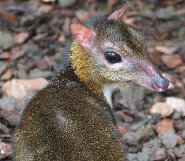 The lesser mouse deer or chevrotain (Tragulus javanicus) is the smallest hoofed mammal in the world. Although it is a shy and secretive forest dwelling relative of the deer and rarely seen, it is very well known throughout Southeast Asia. Its species name T. kanchil recalls its Malay name 'Sang Kancil', a renowned trickster and folk hero.
The lesser mouse deer or chevrotain (Tragulus javanicus) is the smallest hoofed mammal in the world. Although it is a shy and secretive forest dwelling relative of the deer and rarely seen, it is very well known throughout Southeast Asia. Its species name T. kanchil recalls its Malay name 'Sang Kancil', a renowned trickster and folk hero.At first glance, the lesser mouse deer resembles a tiny, rabbit-sized deer that walks on its tiptoes. Adults normally measure about eighteen inches (45 cm) long. Standing on their pencil-thin legs, shoulder height is a mere twelve inches (30 cm), and they weigh about five pounds (2.3 kg). Lesser mouse deer have soft reddish-brown fur marked with a pattern of pale spots or stripes running along the sides of the neck and a pale-colored underside. Unlike deer, the males have no antlers, but do sport a pair of canine teeth that can be seen projecting downward from the upper jaw like two tiny tusks. Males make use of their teeth to defend themselves and their mates against rivals.
The natural habitat of the lesser mouse deer is the moist tropical lowland forest regions of Brunei, Cambodia, Indonesia (Sumatra, Java and Borneo), Laos, Malaysia, Myanmar (Isthmus of Kra), Singapore, southern China, Thailand and Vietnam.
Female mouse deer may give birth to a single fawn at any time of year. Like other hoofed animals, newborn fawns are precocial and stand within thirty minutes of being born. The does wean their fawns at around twelve weeks. The fawns can breed at five to six months, and may live for twelve years.
The natural predators of the lesser mouse deer include crocodiles, snakes, birds of prey and all forest cats. They are taken by humans throughout most of their range for meat and skins. Hunting, trapping, roaming packs of dogs and habitat destruction pose their biggest threats.
Sang kancil (pronounced: Kahn-cheel), the diminutive but wise mouse deer, holds a place of pride in Malay and Indonesian folklore. The tiny hero is cunning and intelligent, and able to prevail over larger tyrants and foes. In these tales, the only thing "lesser" about the lesser mouse deer is his size.
Picture of the lesser mouse deer by Linda Kenney from United Kingdom, licensed under Creative Commons Attribution-Share Alike 2.0 Generic
The Kanchil, lesser mouse deer is listed as Least Concern (LR/lc), lowest risk. Does not qualify for a more at risk category. Widespread and abundant taxa are included in this category, on the IUCN Red List of Threatened Species
Namings for the lesser mousedeer
A young / baby of a lesser mousedeer is called a 'fawn or ass'. The females are called 'doe, hind or cow' and males 'buck, stag or bull'. A lesser mousedeer group is called a 'herd'.Some facts about the
Lesser mouse-deer
Adult weight : 3.85 kg (8.47 lbs)
Maximum longevity : 14 years
Female maturity :167 days
Male maturity : 167 days
Gestation : 144 days
Weaning : 84 days
Litter size : 1
Weight at birth : 0.37 kg (0.814 lbs)
Basal metabolic rate : 5 W
Body mass : 1.616 kg (3.5552 lbs)

Custom Search